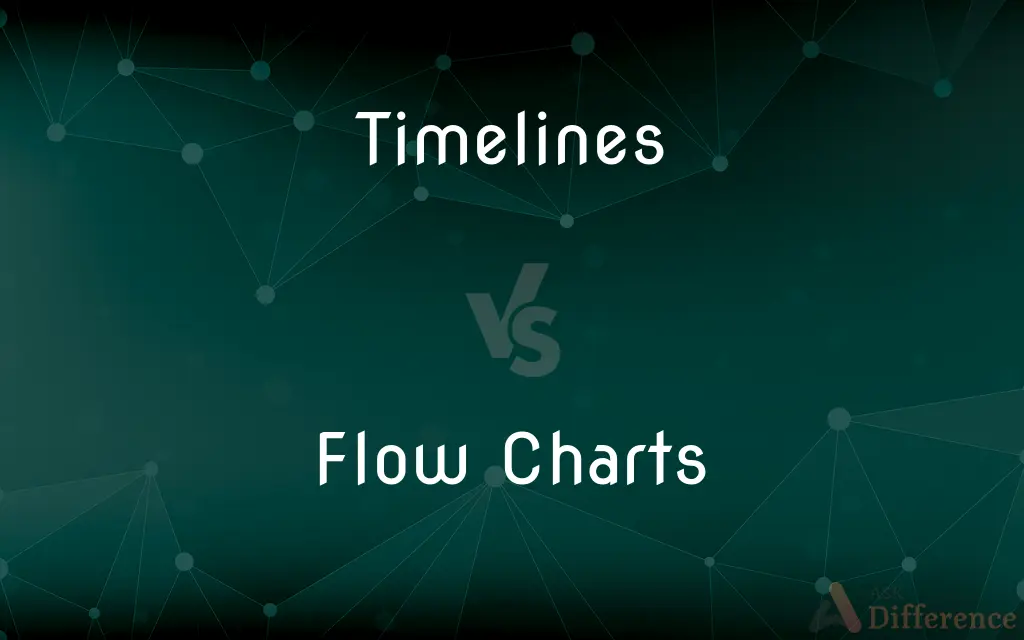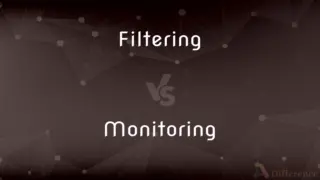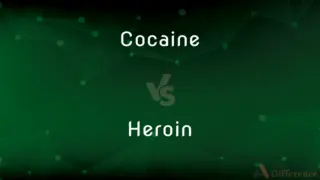Timelines vs. Flow Charts — What's the Difference?
By Fiza Rafique & Maham Liaqat — Published on April 6, 2024
Timelines display events in chronological order, highlighting the sequence and timing of events, while flow charts depict processes, showing steps and decision points in a workflow.

Difference Between Timelines and Flow Charts
Table of Contents
ADVERTISEMENT
Key Differences
Timelines are visual representations that map out events or milestones over a period of time, emphasizing the chronological sequence and temporal relationships between these events. They are particularly useful for historical overviews, project planning, and tracking the development of ideas or products. Timelines are linear, often horizontal, and provide a clear, straightforward way to visualize the timing and order of events.
Flow charts, on the other hand, are used to illustrate processes or workflows. They include steps in a task, decision points, and the flow of operations. Flow charts are more complex than timelines, featuring various symbols like rectangles, diamonds, and arrows that represent actions, decisions, and the direction of flow, respectively. They are essential tools for analyzing, designing, and managing processes in fields ranging from business operations to software development.
Timelines focus on the "when" aspect of events, while flow charts are concerned with the "how" of processes. Timelines are linear, showing events in a direct sequence, whereas flow charts can be more dynamic, with multiple branching paths based on decision outcomes.
The choice between using a timeline or a flow chart depends on the objective of the visualization. If the goal is to understand the chronological order and timing of events, a timeline is most appropriate. However, if the aim is to dissect and communicate the steps of a process or decision-making pathway, a flow chart would be the better tool.
Both timelines and flow charts are invaluable for planning, analysis, and communication, but their applications are distinct. Timelines are best suited for projects and historical data that require a temporal perspective, while flow charts are ideal for mapping out processes and workflows that involve decision-making and task sequences.
ADVERTISEMENT
Comparison Chart
Purpose
To display events in chronological order
To depict processes or workflows
Key Focus
Sequence and timing of events
Steps, decisions, and operations in a process
Structure
Linear, often horizontal
Diagrammatic, with multiple symbols and branching paths
Symbols
Dots, lines, dates
Rectangles (steps), diamonds (decisions), arrows (flow)
Use Cases
Historical overviews, project planning, tracking development
Process analysis, workflow design, operational management
Complexity
Simpler, focusing on temporal relationships
More complex, illustrating decision points and process flow
Visualization
Linear progression
Dynamic, with possible multiple outcomes
Ideal for
Understanding "when" events happen
Understanding "how" processes work
Compare with Definitions
Timelines
Chronological sequence of events.
The museum exhibit featured a timeline of the artist’s life and works.
Flow Charts
Diagram of a process or workflow.
The training manual included a flow chart of the customer service process.
Timelines
Linear representation.
The timeline on the wall displayed the company’s history over the last 50 years.
Flow Charts
Used for workflow design.
The software developers designed a flow chart to outline the new application’s architecture.
Timelines
Emphasizes timing and order.
Their project timeline outlined all major milestones and deadlines.
Flow Charts
Illustrates steps and decisions.
They used a flow chart to map out the decision-making process for approving projects.
Timelines
Used for tracking development.
The development team created a timeline to track the progress of their software release.
Flow Charts
Helps in process analysis.
The team created a flow chart to identify bottlenecks in the production line.
Timelines
Focuses on temporal relationships.
The timeline in the book helped readers understand the sequence of historical events.
Flow Charts
Features symbols for actions and flow.
The flow chart for the emergency evacuation plan was posted in every classroom.
Timelines
A schedule of activities or events; a timetable.
Timelines
A representation or exhibit of key events within a particular historical period, often consisting of illustrative visual material accompanied by written commentary, arranged chronologically.
Timelines
Plural of timeline
Common Curiosities
Can a flow chart have multiple endings?
Yes, flow charts can have multiple endings or outcomes based on decision points within the process.
Why would someone use a timeline instead of a flow chart?
Someone would use a timeline instead of a flow chart when the goal is to understand the chronological order and timing of events, rather than the steps of a process.
What is the primary purpose of a timeline?
The primary purpose of a timeline is to display events in chronological order, highlighting the sequence and timing of these events.
What is a flow chart used for?
A flow chart is used to depict processes or workflows, showing steps, decision points, and the flow of operations.
Are flow charts more complex than timelines?
Yes, flow charts are generally more complex than timelines because they illustrate decision points and process flows, which can branch in multiple directions.
What symbols are commonly used in flow charts?
Common symbols in flow charts include rectangles for steps or actions, diamonds for decision points, and arrows to indicate the flow direction.
Can timelines show the duration of events?
Yes, timelines can show the duration of events by indicating the start and end dates or times, providing a visual representation of how long events last.
How do timelines and flow charts differ in structure?
Timelines are linear and often horizontal, focusing on temporal relationships, while flow charts are diagrammatic with various symbols indicating actions, decisions, and the direction of flow.
How do timelines help in project planning?
Timelines help in project planning by outlining all major milestones and deadlines, enabling teams to track progress and manage time effectively.
What is the advantage of using a flow chart in operational management?
The advantage of using a flow chart in operational management is that it helps identify bottlenecks, streamline processes, and improve efficiency by clearly illustrating steps and decisions in a workflow.
Share Your Discovery

Previous Comparison
Filtering vs. Monitoring
Next Comparison
Cocaine vs. HeroinAuthor Spotlight
Written by
Fiza RafiqueFiza Rafique is a skilled content writer at AskDifference.com, where she meticulously refines and enhances written pieces. Drawing from her vast editorial expertise, Fiza ensures clarity, accuracy, and precision in every article. Passionate about language, she continually seeks to elevate the quality of content for readers worldwide.
Co-written by
Maham Liaqat















































